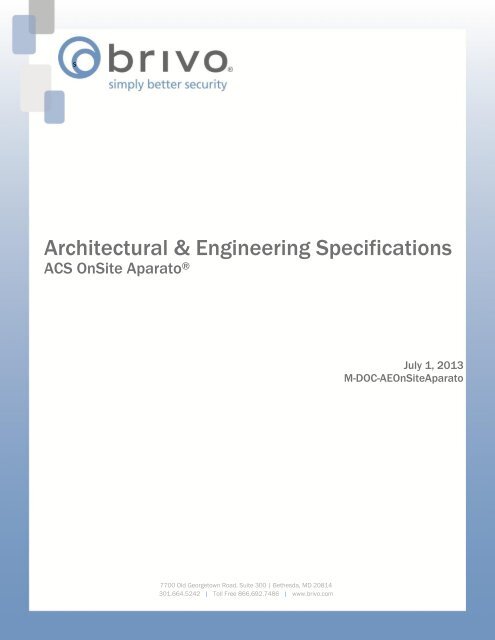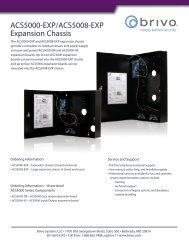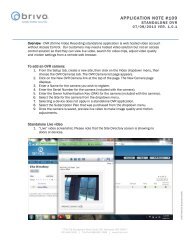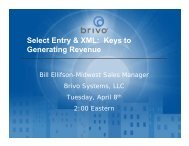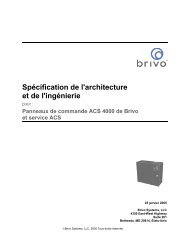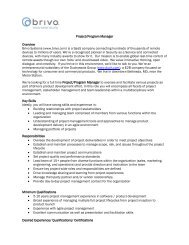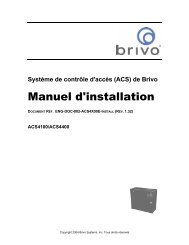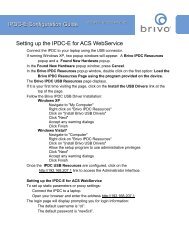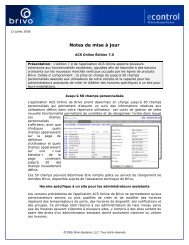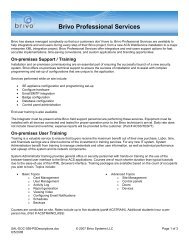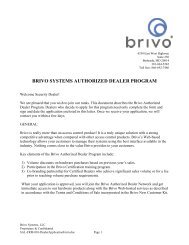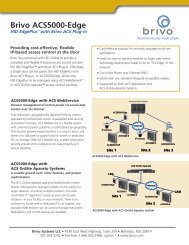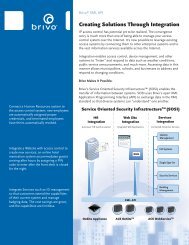ACS OnSite Aparato A&E Specifications - Brivo Systems
ACS OnSite Aparato A&E Specifications - Brivo Systems
ACS OnSite Aparato A&E Specifications - Brivo Systems
Create successful ePaper yourself
Turn your PDF publications into a flip-book with our unique Google optimized e-Paper software.
sArchitectural & Engineering <strong>Specifications</strong><strong>ACS</strong> <strong>OnSite</strong> <strong>Aparato</strong> ®July 1, 2013M-DOC-AE<strong>OnSite</strong><strong>Aparato</strong>[Type text] 7700 Old Georgetown Road, Suite 300 | Bethesda, MD 20814301.664.5242 | Toll Free 866.692.7486 | www.brivo.com7700 Old Georgetown Road, Suite 300 | Bethesda, MD 20814301.664.5242 | Toll Free 866.692.7486 | www.brivo.com
Page 1 Architectural and Engineering <strong>Specifications</strong>: <strong>Aparato</strong> ®Legal DisclaimersCanada-Underwriters Laboratories (C-UL) CompliancyFor C-UL Listed applications, the unit shall be installed in accordance with Part 1 of the CanadianElectrical Code.Documentation Disclaimer and RestrictionsInformation in this document is subject to change without notice and does not represent acommitment on the part of <strong>Brivo</strong> <strong>Systems</strong>, LLC. For the most up-to-date information, visitwww.brivo.com.This document and the data herein shall not be duplicated, used or disclosed to others forprocurement or manufacturing, except as authorized with the written permission of <strong>Brivo</strong> <strong>Systems</strong>,LLC. The information contained within this document or within the product itself is considered theexclusive property of <strong>Brivo</strong> <strong>Systems</strong>, LLC. All information in this document or within the hardware andsoftware product themselves is protected by the copyright and/or other intellectual property laws ofthe United States.Product SupportAll support for this product is provided by the third-party dealer. Please contact the dealer whoinstalled the product with questions and support requests.© 2013 <strong>Brivo</strong> <strong>Systems</strong>, LLC. All rights reserved.The <strong>Brivo</strong> logo is a registered trademark of <strong>Brivo</strong> <strong>Systems</strong>, LLC.<strong>Brivo</strong> <strong>Systems</strong>, LLC7700 Old Georgetown RoadSuite 300Bethesda, MD 20814Phone: (301) 664-5242Fax: (301) 664-5264www.brivo.comThis Architectural and Engineering Specification document utilizes the Construction <strong>Specifications</strong>Institute (CSI) Project Resource Manual (PRM), including MasterFormat, SectionFormat andPageFormat. The purpose of this document is to specify the Architectural/Engineering and Bidcriteria for a Web-based, IP (Internet Protocol) based Access Control Appliance using suchtechnologies as the Internet, private corporate networks, or wireless cellular networks.This Architectural and Engineering Specification document specifies access control equipment andservices. Equipment specifications include control panels, expansion chassis, I/O boards,door/reader control boards, and power supplies. Services include Web-based monitoring and controlservices to manage control panels. These products and services are manufactured and/or provided by<strong>Brivo</strong> <strong>Systems</strong>, LLC.© 2013 <strong>Brivo</strong> <strong>Systems</strong>, LLC. All rights reserved. 7/1/2013
Page 2 Architectural and Engineering <strong>Specifications</strong>: <strong>Aparato</strong> ®PART 1 GENERAL1.01 SUMMARYSECTION 28 13 00ACCESS CONTROLA. This section includes a description of Web-based access control devices, intrusiondetection devices, security access devices, relay control, alarm monitoring controllers,credential creation, and credential holder database and management.B. Related Sections1. Section 08 74 00 – Access Control Door Hardware2. Section 28 13 33 – Access Control Interfaces3. Section 28 13 43 – Access Control Identification Management <strong>Systems</strong>4. Section 28 23 00 – Video Surveillance5. Section 27 05 33 – Pathways for Communications6. Section 27 10 00 – Structured Cabling7. Section 27 15 00 – Access Control Communications Horizontal Cabling8. Section 28 13 49 – Access Control Web Interface1.02 DEFINITIONSA. <strong>ACS</strong>: Access Control ServerB. RTOS: Real-Time Operating SystemC. SDC: Security Door ControllerD. IEC: Independent Edge ControllerE. TPM: Trusted Platform ModuleF. AES: Advanced Encryption StandardG. LAN: Local Area NetworkH. WAN: Wide Area NetworkI. SSH: Secure ShellJ. SSL: Secure Socket LayerK. SIA: Security Industry AssociationL. ISO: International Standards OrganizationM. HSPD-12: Homeland Security Presidential Directive # 12N. FIPS 201: Federal Information Processing Standard 201, Personnel Information andVerification standard for Government AgenciesO. CHUID: Card Holder Unique IdentificationP. USGIC: U.S. Government Issued CredentialQ. DNS: Domain Name SystemR. DHCP: Dynamic Host Configuration Protocol© 2013 <strong>Brivo</strong> <strong>Systems</strong> LLC. All rights reserved. 7/1/2012
Page 3 Architectural and Engineering <strong>Specifications</strong>: <strong>Aparato</strong> ®S. IP: Internet ProtocolT. UI: User InterfaceU. PoE: Power over Ethernet1.03 REFERENCESA. Underwriters Laboratories, Inc. (UL) (www.ul.com)1. UL294 – Underwriters Laboratory Safety Standard 294 for Access ControlSystem products.1.04 QUALITY ASSURANCEA. Manufacturer shall be capable of providing field service representation duringconstruction and approving application method.1.05 WARRANTYA. Refer to conditions of the contract for project warranty provisions.B. The manufacturer shall warrant that the hardware product(s) are free from defect inmaterials and/or workmanship for a period of one (1) year from the date of shipment.1.06 PERFORMANCEA. The appliance shall conform to Energy Star Power and Performance standardsB. Performance measurements shall be bench marked using Sandra Dhrystone 4.21.07 MAINTENANCEA. The <strong>ACS</strong> manufacturer shall provide periodic software upgrades. When changes aremade to the appliance software, those updates will be available to the customer via thesoftware support agreement.1.08 SUPPORTA. On-site support shall be provided by the local authorized installation company.B. Installing company shall provide evidence that it is an authorized dealer in goodstanding for the manufacturer of the On-Site system, and that it meets themanufacturer’s technical certification requirements.1.09 SYSTEM DESCRIPTIONA. Application Functions1. All access control data shall be managed and maintained through a Web-basedinterface to the <strong>ACS</strong> appliance.2. All Access and System events shall include a time stamp when the eventoccurred, and shall be based on standard Greenwich Mean Time (GMT).3. The system shall include the ability to make configuration changes necessary forensuring data integrity and facility security.4. The <strong>ACS</strong> shall provide a wide range of communications protocols to control fieldpanels so that all commands and updates to the panels are verified and shall beretried if communication attempts fail.5. The <strong>ACS</strong> shall be capable of automatically discovering the Security DoorController (SDC) field panel configuration and setup all necessary parameters toestablish proper communication.6. The system shall provide firmware installation capabilities to all connected SDCpanels.© 2013 <strong>Brivo</strong> <strong>Systems</strong> LLC. All rights reserved. 7/1/2012
Page 4 Architectural and Engineering <strong>Specifications</strong>: <strong>Aparato</strong> ®B. System Architecture1. The access control system shall consist of a centralized Access Control Server(<strong>ACS</strong>), scalable in configuration and capable of spanning geographically from asingle facility to multiple facilities; enabling managed access control to remotelyconnected facilities worldwide.a. The <strong>ACS</strong> shall reside at any one facility within the security infrastructure, asdetermined by the solution design.2. The <strong>ACS</strong> shall maintain all configuration data for the entire system and shallfunction in a secure distributed architecture, sending configuration changes to,and receiving event activity from: Security Door Controllers (SDC), door edgedevices, or I/O modules through secure encrypted channels.3. The <strong>ACS</strong> appliance itself shall be secure, offering only the network servicesnecessary to perform its functions and capabilities.a. Ethernet network protocols shall be limited to the following inbound ports:1) HTTP port 802) HTTPS port 4433) SSL ports 56079 & 56080b. Outbound ports shall be limited to the following network ports:1) NTP port 1232) SSH port 224. The <strong>ACS</strong> shall be a rack-mountable server class computer, running a LinuxRTOS and shall perform as a standalone access control appliance utilizing anembedded Web server and software interface designed for access controlapplications up to 1000 readers.a. All administrative data management shall be performed using an InternetBrowser connection to the <strong>ACS</strong> appliance across a secure 128-bit SSLchannel.5. The <strong>ACS</strong> appliance shall include an integrated Trusted Platform Module (TPM)providing hardware-backed, software integrity verification.a. The <strong>ACS</strong> shall fully encrypt data storage using a 256-bit key AdvancedEncryption Standard (AES-256).b. The <strong>ACS</strong> shall comply with ISO Standard 11889 to:1) Ensure stored data is protected against software attacks and greatlysecured in case of physical theft of the device.2) Guard against unauthorized modification of application software andprovide tamper detection.3) Simplify software upgrades by eliminating tokens and other peripheralsecurity measures.6. Encryption & Authenticationa. Communications between Security Door Controller (SDC) panels and the<strong>ACS</strong> appliance shall be encrypted using 128-bit SSL encryption.b. The <strong>ACS</strong> shall include the capability to use FIPS 140-2 validated embeddedencryption modules for all network communications.c. The <strong>ACS</strong> appliance shall validate the identity of any SDC panel attemptingto communicate with it through the exchange of X.509 digital certificates.7. Encrypted Data Storagea. Live database shall be encrypted utilizing AES-256 encryption standards.b. Back- up files shall be compressed and encrypted.© 2013 <strong>Brivo</strong> <strong>Systems</strong> LLC. All rights reserved. 7/1/2012
Page 5 Architectural and Engineering <strong>Specifications</strong>: <strong>Aparato</strong> ®c. The system shall include the capability to utilize back-up facilities fromauthorized Internet hosting services and shall use SSH encryption fortransmission of encrypted back-up file.8. Network Communicationsa. The <strong>ACS</strong> shall utilize Ethernet communications as its primarycommunications medium and shall conform to IEEE 802.3 industrystandards for typical computer based network connectivity.1) Ethernet connections shall use industry standard 8P8C modularconnectors and shall conform to TIA/EIA-568-B wiring standards.b. The <strong>ACS</strong> appliance shall include support for the following minimumnetwork configuration settings:1) DHCP2) Static IP Addressi) Internet Protocol version 4 (IPv4)3) Network Mask4) Gateway Address5) Primary DNS6) Secondary DNSc. The <strong>ACS</strong> shall support static route configuration as required. Configurationentries shall include, but not be limited to, the following settings:1) Destination IP Address2) Gateway3) Network Mask9. Security Door Controller (SDC)a. SDCs shall represent multiple door controller devices including, but notlimited to:1) Multi-Door Controller Hubi) SDCs multi-door controller hubs shall be fully expandable from aminimum of 1 reader up to 30 readers.ii) SDCs shall include a UL-listed chassis and power supply designedto accommodate a variety of expansion options.iii) SDCs shall include the ability to maintain a minimum of 25,000cardholders.2) Independent Edge Controller (IEC).i) Each IEC shall have the ability to maintain a minimum of 25,000card holders and a minimum of 5,000 off-line events.ii) IECs shall include Power-over-Ethernet (PoE) capabilities, withthe ability to supply at least 700mA of auxiliary power for externallock and/or REX devices.iii) IEC PoE shall conform to the IEEE 802.3af standard.b. The <strong>ACS</strong> shall provide a seamless programming environment and shall fullyintegrate IECs and SDCs as integral components of the system.c. Communications options shall include:1) 10/100Mbs Ethernet.2) CAN Bus - Use CAT5 (or higher) UTP cable up to 1,500 feet.C. Accounts© 2013 <strong>Brivo</strong> <strong>Systems</strong> LLC. All rights reserved. 7/1/2012
Page 6 Architectural and Engineering <strong>Specifications</strong>: <strong>Aparato</strong> ®1. <strong>ACS</strong> shall permit authorized operators the ability to create sub level accounts,dividing database configuration and system operation between multiple,manageable access control entities.a. Accounts beneath the “System Account” shall be limited to a singlehierarchal level.b. All sub-accounts shall have a sibling relationship with other sub-accounts.1) Sub-account administrators shall not have the ability to edit or viewadministrators from other accounts.c. The “System Account” shall be the parent of all sub-accounts.d. The “System” account shall represent the system owner and shall permitcomplete control of the entire system and all connected and configureddevices.e. Sub-accounts shall have a limited view of the system, and shall include acompletely separate set of users, device configuration, and other accesscontrol configuration criteria.f. All sub-account data shall be completely separate and isolated from othersub-accounts.2. System shall include the default capacity for 8 accounts with options to increasecapacity up to 128 accounts.3. Authorized account administrators shall have the ability to edit otheradministrators within the same account.4. Authorized system administrators shall have the ability to view and edit allaccount administrators from all sub-accounts maintained within a single <strong>ACS</strong>appliance.D. Schedules and Holidays1. The <strong>ACS</strong> shall provide the ability to define custom schedules for the purpose ofmanaging facility access and operating auxiliary devices with the followingoptions:a. Create and edit a schedule. The <strong>ACS</strong> shall permit up to 32 time periods perday.b. Associate a schedule with groups, floors, doors, and/or devices.c. Terminate a schedule’s association with one or more groups, floors, doors ordevices.d. Delete a schedule.e. Create and edit a Holiday.f. Edit a Holiday’s start and end date.g. Delete a Holiday.h. Support for one time repeating schedule exceptions, one time or up to 16timesE. Doors and Devices1. Doors:a. Each account may have one or more doors associated with it.b. Administrators shall be allowed permission to manage doors, includingpermission to create the door, edit its name, and manage its security settings.2. Devices:a. Bulk Device Management via Device Profiles1) The <strong>ACS</strong> shall permit authorized administrators the ability to assign“profiles” such as schedules and permissions to doors, inputs, andcredentials.© 2013 <strong>Brivo</strong> <strong>Systems</strong> LLC. All rights reserved. 7/1/2012
Page 7 Architectural and Engineering <strong>Specifications</strong>: <strong>Aparato</strong> ®b. A device may have logical or physical inputs and outputs.c. A logical input may be a schedule input to a timer.d. A physical input is any physical input point on a SDC board.e. An account can have one or more devices associated with it.f. Administrators shall be allowed permission to manage devices, includingpermission to create the device, edit its name, and manage its securitysettings.F. Elevators and Floors1. Authorized administrators shall have permission to manage elevators and floorsincluding, but not limited to:a. Creating the elevator or floor.b. Editing its name.c. Managing its settings.G. Credentials: Credential Database and Cards1. Credential Databasea. The <strong>ACS</strong> shall support multiple credentials per user.b. The <strong>ACS</strong> software interface shall maintain a database of all credentialsassociated with the account or sub-account, and the user to whom each isassigned.c. Operations to be performed by the interface shall include, but not be limitedto:1) Validate that card numbers are unique, numeric, and value isappropriate for the credential in use.2) Support the creation of PIN credentials that are unique, 4 to 8 digitslong, and either randomly generated by the system or selected by theuser.3) Automatically send updated credential information to the appropriateaccess control panels with no other user intervention.4) Provide up to 64 customized fields per account for data storagepertaining to individual credential holders (users) registered in thesystem.d. The <strong>ACS</strong> shall fully support U.S. Government Issued Credentials (USGIC)including: HSPD-12/FIPS-201 PIV, TWIC, NG CAC, and FRAC.1) The system shall provide the capability to register the FASC-N, photo,and printed information from the USGIC to the <strong>ACS</strong> platform.2) The <strong>ACS</strong> shall immediately disable cardholder’s access authorizationupon detection of revoked or invalid certificate status.e. The <strong>ACS</strong> Certificate Manager shall support Caching Status Proxy providingthe additional capability of re-validating imported cardholder certificates ona periodic basis and suspending revoked badges automatically within the<strong>ACS</strong>.f. The <strong>ACS</strong> shall support Black-List checking to determine if a credential suchas a certificate or FASC-N is valid.g. The <strong>ACS</strong> shall support Online Certificate Status Protocol (OCSP), providingdynamic validation of the USGIC during pre and post credential registration.2. Cardsa. May be assigned, revoked, or deleted.© 2013 <strong>Brivo</strong> <strong>Systems</strong> LLC. All rights reserved. 7/1/2012
Page 8 Architectural and Engineering <strong>Specifications</strong>: <strong>Aparato</strong> ®b. Authorized operators shall have the capability to see all cards associatedwith an account.c. Sub-account administrators shall be capable of viewing only those cardsassigned to users affiliated with their accountd. Sub-account administrators shall have the ability to view currentlyunassigned cards.e. The <strong>ACS</strong> software interface shall provide the capability to display the cardformat in addition to the name of the user to whom the card is currentlyassigned.f. Cards shall be listed in numeric order.g. Deleted cards may be reinstated if necessary.h. The <strong>ACS</strong> shall provide the capability to add cards using a local card reader.i. The <strong>ACS</strong> shall provide the ability to support custom Wiegand Binary, BCDencoded, and 5-bit BCD+parity encoding.j. The <strong>ACS</strong> shall provide the ability to support an unlimited number ofstandard and custom formats.H. ID Badging1. The <strong>ACS</strong> shall provide the necessary capabilities to allow authorized operatorsthe ability to create fully customizable badge templates.2. The <strong>ACS</strong> shall provide all necessary functionality to display images and printbadges directly from the operator’s screen.3. The system shall include, but not be limited to, the following badge elements andassociated properties:a. Static Text Objects: Text, Color, Background Color, Text Size, Position,Dimensions, Font, Multiline, Scale to Fit, Alignment, Vertical Placementand Orientation.b. Photo Objects: Position, Dimensions, Background Color, and Aspect Ratioc. Static Image Objects: Filename, Position, Dimensions, Background Colorand Aspect Ratio.d. Boxes: Background Color, Position, Alignment, and Dimensionse. Barcodes: Encoding, Custom Field, Position, Dimensions, and Orientation.f. Standard <strong>ACS</strong> Field Objects: Color, Background Color, Text Size andPositionI. Threat Levels1. The <strong>ACS</strong> shall permit the definition of an unlimited number of Threat Levels.a. Threat levels shall affect system wide operational functionality relative tothe association to other system objects.b. A threat level range can be defined so that it controls:1) Group permissionsi) Each threat level shall permit association to group permission,thereby invoking an alternate set of permissions under differentthreat levels.2) Administrator rolesi) Each threat level shall permit the association to an administrationrole, thereby changing roles of system operators under differentthreat levels.3) Schedules© 2013 <strong>Brivo</strong> <strong>Systems</strong> LLC. All rights reserved. 7/1/2012
Page 9 Architectural and Engineering <strong>Specifications</strong>: <strong>Aparato</strong> ®i) Each threat level shall permit the association to a system scheduleand shall change schedules based on current threat level.4) Devices shall follow threat level settings as part of logical inputprocessing.5) Two-factor credentialsi) Threat levels shall include the capability to associate multi-factorauthentication mechanisms, increasing or decreasing the securityrequirements for authorized access.2. Threat levels shall allow association of any defined element listed above, andshall change the result based on the threat level selected.a. The system shall include an option for selected access groups to be exemptfrom threat level policies.J. Antipassback1. Across panelsa. The system shall provide antipassback capabilities across all field panelscontained within the <strong>ACS</strong>.b. Antipassback status shall not be limited to a single field panel2. Multi-zonea. The <strong>ACS</strong> shall permit authorized operators the ability to assign multipledoors to an antipassback area.b. The <strong>ACS</strong> shall permit authorized operators the ability to create multipleantipassback areas.3. Nesteda. The <strong>ACS</strong> shall include the ability to nest antipassback areas within otherantipassback areas.K.1. Guard Toura. The system shall provide a flexible way to specify where and when a guardin at their designated tour stop or area while performing roundsb. The system shall generate a notification when a tour is missed, overdue orcompleted.L. Mustering1. The <strong>ACS</strong> shall support multi-zone muster stations.2. Mustering capabilities shall be based on threat level control, and shall have theability to provide alternate configurations for each threat level.M. Graphic maps1. Reference Section 28 13 49 – Web-based Management Interface forspecifications.N. The <strong>ACS</strong> shall support external reporting engines via ODBC connectivity.O. Video Integration1. The <strong>ACS</strong> shall restrict access to both live and archive playback by specificpermissions to authorized administrators only.2. The system shall provide basic capabilities to tag video clips based on <strong>ACS</strong>events.3. The <strong>ACS</strong> shall provide authorized administrators the ability to retrieve a videosegment related to a specific event.© 2013 <strong>Brivo</strong> <strong>Systems</strong> LLC. All rights reserved. 3/1/2013
Page 10 Architectural and Engineering <strong>Specifications</strong>: <strong>Aparato</strong> ®4. The <strong>ACS</strong> shall use the time stamp of the event and camera identifier to query theDVR for event clips.a. The DVR shall return the requested video stream for the time and cameraindicatedb. The <strong>ACS</strong> shall play the retrieved video in a popup window.c. Video images shall be streamed directly from the DVR to the browser popupwindow.5. Time synchronization between the <strong>ACS</strong> and the DVR shall utilize NTP protocol,and shall be used to maintain data integrity between the separate systems.6. DVRs shall communicate with the <strong>ACS</strong> using Ethernet communications.P. System Administrators1. Full Role-based Administrative Security Modulea. The <strong>ACS</strong> shall permit unlimited user defined Administrative rolesb. The <strong>ACS</strong> shall provide a minimum of 30 capabilities per role.1) The <strong>ACS</strong> shall include up to 4 permission levels per capability.2. Administrators of the “System Account” have full access to the system.a. Sub-account administrators shall have access restricted to their respectiveaccounts.b. The <strong>ACS</strong> shall maintain the following minimum data elements for alladministrator accounts:1) First Name2) Last Name3) Administrator ID4) Password3. The <strong>ACS</strong> shall validate all administrators’ access to the application and shalltrack all changes made to the database.a. The <strong>ACS</strong> shall generate and display a non-editable, printable journal of alladministrative actions performed on the account for the purpose ofmaintaining an unalterable audit trail.4. Administrators shall have the ability to manage control panel-related data.a. Control panel-related data shall be available once optionally selected on anadministrator’s configuration page and saved after editing.b. Manageable abilities shall include:1) Assigning names to panels.2) Link panel to control boards and elevators.3) Define and manage control panels for the account.4) Define and manage control boards.5) Add doors to an account and associate them with control panels.6) Enable/disable the Door Ajar feature, and control the Door AjarThreshold.7) Define and edit an Invalid PIN threshold and define an associatedshutdown period.8) Define and edit a Pass-through Period.9) Manage Request-to-Exit motion sensors.10) Enable and disable Alarm Shunts and define Alarm Shunt Delay time.11) Delete doors from an account.12) Add devices to an account and associate them with control panels.© 2013 <strong>Brivo</strong> <strong>Systems</strong> LLC. All rights reserved. 3/1/2013
Page 11 Architectural and Engineering <strong>Specifications</strong>: <strong>Aparato</strong> ®13) Define each device as a Switch Input Device, Schedule ControlledDevice, Valid Credential Input Device, or Event Triggered Device.14) Manage a device’s output behavior.15) Determine if and how a device should be tracked in the ActivityReport.16) Delete devices from an account.17) Add elevators and associate them with control panels.18) Associate each elevator with one or more floors.19) Associate each elevator with a card reader.20) Delete elevators.21) Add floors to an account.22) Define and edit an “Unlock Schedule” for each floor.23) Delete floors.Q. Users and Groups1. Manages users who have access to the resources associated with an account, andassign those users to groups that define access privileges, such as the followingprivileges:a. Define a user groupb. Edit access privileges for a group of usersc. Delete a user groupd. Create a new usere. Assign a unique 4- to 8-digit PIN to a userf. Change a user’s PINg. Delete a user’s PINh. Assign a unique card number to a useri. Change user’s card numberj. Revoke a user’s card numberk. Define a user’s Start Datel. Define a user’s Termination Datem. Change a user’s Termination Daten. Delete a user’s Termination Dateo. Assign a user to one or more groupsp. Remove a user from one or more groupsq. Delete a userR. Email Notifications1. Dispatches email notifications to select administrators when one of the followingpredetermined events occur:a. Door Ajar/Door Ajar Clearedb. Door Forced Openc. Too Many Invalid PINsd. Door Locked by Timere. Door Unlocked by Timerf. Failed Access by Unknown Persong. Failed Access by Known Personh. Failed Access by a user within a groupi. Successful access by a user within a groupj. Successful access by a specific userk. Device Engaged/Disengaged© 2013 <strong>Brivo</strong> <strong>Systems</strong> LLC. All rights reserved. 3/1/2013
Page 12 Architectural and Engineering <strong>Specifications</strong>: <strong>Aparato</strong> ®l. Control Panel/Control Board Unit Opened/Closedm. AC Power Loss/Restoration and Battery Statusn. Account administrators shall have the ability to manage email notificationsaccording to functionality listed below:1) Create and edit notification rules specifying which administrator shouldreceive email notification of which system events2) Associate a schedule with each notification rule3) Specify the language to be used in notification emails4) Delete notification rulesS. Advanced Programming Logic1. The <strong>ACS</strong> should include tools needed for building customized and complex IOsolutions such as:a. Keypad Command devices that allow definable numeric sequences (1-999)to trigger Relay Outputs, Schedules and Threat Levels.b. Toggle, Activate, Deactivate and Wait Timer output behaviorsc. Schedule ControlsT. Reports1. The <strong>ACS</strong> shall include an Activity Report tool that tracks all attempts to accessthe sites associated with an account, including both successful and failedattempts, with the following options:a. Display the Activity Report unfiltered, so that all activities are listedb. Display the Activity Report filtered by user, so that only those actionsperformed by a specific user are displayedc. Display the Activity Report filtered by site, so that only those actionsperformed at a specific site are listedd. Display the Activity Report filtered by door or device, so that only thoseactions performed on a specific door or device are listede. Allow administrators to search the Activity Report for exception events,user events, control panel events and device events, searching by absolutedate or relative daysf. Allow administrators to search the Activity Report for events related to aspecific door or deviceg. Allow administrators to search the Activity Report for actions performed bya specific user on a specific door.h. Allow users to run predefined commonly run reportsi. Reporting Feature should have established data so they do not require userinput.j. Scheduled Reports should allow either predefined or new reports to be runon a define schedule.U. Licensing1. The <strong>ACS</strong> manufacturer shall offer flexible licensing of software capabilities.V. XML Interface1. The <strong>ACS</strong> shall provide API support for XML-RPC integration with 3 rd partyproducts providing capabilities such as:a. Automatically adding cards and user photos from external sources.b. Supporting HSPD–12-compliant solutions for Personal IdentificationVerification (PIV) and Certificate management.c. Time and Attendance systems.© 2013 <strong>Brivo</strong> <strong>Systems</strong> LLC. All rights reserved. 3/1/2013
Page 13 Architectural and Engineering <strong>Specifications</strong>: <strong>Aparato</strong> ®PART 2 PRODUCTS2.01 MANUFACTURERd. Parking control systems.e. Human Resource <strong>Systems</strong>.A. <strong>Brivo</strong> <strong>Systems</strong> LLC1. 4330 East West Highway, Suite 250, Bethesda, MD 20814a. Telephone: (301) 664-5242b. Fax: (301) 664-5264c. Website: http://www.brivo.com.2.02 PRODUCT SUBSTITUTIONSA. No substitutions permitted.2.03 SYSTEM COMPONENTSA. Access Control Server (<strong>ACS</strong>)1. <strong>ACS</strong> <strong>OnSite</strong> <strong>Aparato</strong>a. 19” Rack-mount (1U)b. System requires no additional user-installed software.c. System software requires no maintenance after initial installation.B. Security Door Controllers (SDC)1. <strong>ACS</strong>5000-A/<strong>ACS</strong>5008-A Door Control Panelsa. Expandable modular design.b. Individually fused interface boards, locks, and REX devices.c. Door tamper switch.d. Power loss detection and automatic battery backup.2. HID EdgeReader/EdgePlusa. Built-in 802.3af Power over Ethernet (PoE)1) EdgeReader - 600mA available for external field devices2) EdgePlus - 700mA available for external field devicesb. Compatible reader protocols include all Wiegand or HID formats up to 128bits and iCLASS RS-232.3. Wireless Locksetsa. The HSMS shall have the capability to integrate with wireless locksets fromtwo manufacturers.1) IP locksetsi. Salto Sallis2) Wiegand locksetsi. Schlage IR AD4004. <strong>Brivo</strong> IP Door Controller (IPDC-A)a. Built-in 802.3af Power over Ethernet(PoE)1) 750mA available for external field devicesb. Compatible reader protocols include all Wiegand or HID formats up to 128bits and iCLASS RS-232c. Authentication and encryption of X.509 Digital Certificates and 128-bitSSL; FIPS 140-2C. Ancillary Components© 2013 <strong>Brivo</strong> <strong>Systems</strong> LLC. All rights reserved. 3/1/2013
Page 14 Architectural and Engineering <strong>Specifications</strong>: <strong>Aparato</strong> ®1. Card Readers – Wiegand Interfacea. HIDb. XceedIDc. FarpointD. USGIC Registration and Certificate Management1. Codebench PIVChecka. Credential Registration1) FASC-N2) Photo3) CHUIDb. Caching Status Proxyc. Online Certificate Status Protocol (OCSP)d. Black-List Checking Support2.04 APARATO APPLIANCEA. Capacities:1. Support for up to 500,002 credential holders per appliance2. Supports up to 1,000 readers3. Inputs:a. Maximum 30,000 using the <strong>ACS</strong>5000 and expansion boards4. Outputs:a. Up to 30,000 auxiliary outputs using the <strong>ACS</strong>500 and expansion boards5. Event buffering:a. 10,000,000 events in a circular queue6. User-definable fields:a. 64 per account7. Credentials:a. Up to 500,002 active card holdersb. Up to 5 cards per card holder8. Elevator control:a. 118 floorsB. Hardware1. <strong>Brivo</strong> Server Class Chassis, 1U.a. TPM moduleb. 4GB Memory (2x2GB), 1066MHz Dual Ranked UDIMMc. X3430 Xeon Processor, 2.4GHz, 8M Cache, Turbo or greaterd. 160GB 7.2k RPM Serial ATA Hard Drive or greatere. On-Board Dual Gigabit Network Adapter1) Integrated 8P8C modular connector2) TIA/EIA-568 wiring standardf. DVD-ROMg. NEMA 5-15P to C13 wall plug, 10 feetC. Trusted Computing Module (TPM) compliant with ISO Standard 118891. Hardware-backed software integrity verification2. Fully encrypted data storage using AES 256D. FIPS 140-2 Validated Encryption1. Optionally utilizes FIPS 140-2 validated embedded encryption modules for allcommunications.© 2013 <strong>Brivo</strong> <strong>Systems</strong> LLC. All rights reserved. 3/1/2013
Page 15 Architectural and Engineering <strong>Specifications</strong>: <strong>Aparato</strong> ®E. Software/Firmware1. <strong>ACS</strong> <strong>OnSite</strong> <strong>Aparato</strong> , proprietary software designed and developed by <strong>Brivo</strong><strong>Systems</strong> LLC.2. Browser-based access control Platforma. Open standards based clientb. No dedicated client workstations or licenses requiredc. Lowest TCO3. Flexible licensing of software capabilities by feature and capacity.4. Browser-based software upgrades.5. Support for automated backups to a network drive.F. Dashboard1. Dynamic system activity log with corresponding time-stamp and device name.2. View system activity based on account permissions.3. Display filtering of device status.4. Configuration of output control for system devices including:a. Pulseb. Latchc. Unlatchd. Togglee. Follow5. Display Activity and Status Lists.6. Device Status and Hardware Status list.7. Momentarily unlock doors.8. Live Status displays physical status of a door as open or closed, also reports endof line supervision.9. Threat Level icon enabling authorized administrators to engage and disengage asystem-wide lockdown capability.G. Graphic maps1. Unlimited nested maps.2. Navigate between maps via hot links.3. Bit map files imported:a. GIFb. PNGc. JPG4. Icons representing devices.5. Real-time status updates via color coded icons.6. Zone alarm linking between nested maps.7. Ability to control devices from map.H. Video Integration1. Support Commercially available NVR/DVR SolutionsI. ID Badging1. Fully customizable badge designer and support for badge printing from the userscreen.2. Support for a wide variety of USB cameras.J. Host communications:1. TCP/IP Protocola. DHCPb. Static IP© 2013 <strong>Brivo</strong> <strong>Systems</strong> LLC. All rights reserved. 3/1/2013
Page 16 Architectural and Engineering <strong>Specifications</strong>: <strong>Aparato</strong> ®K. Threat Levels1. Threat level control:a. Group permissionsb. Admin rolesc. Schedulesd. Devicese. Two-factor credentialsf. Card Required ScheduleL. Antipassback1. Global - across all connected panels2. Multi-zone3. NestedM. Mustering1. Multi-zone muster stations2. Threat Level ControlN. Full Role-based Administrative Security Module1. Unlimited user defined Administrative roles.2. 30+ capabilities per role.3. 4 permission levels per capability.O. Bulk Device Management via Device Profiles1. Assign “profiles” such as schedules and permissions to doors, inputs, andcredentials.P. Encrypted Data Storage1. Live database is encrypted via AES 256.2. Back- up files are compressed and encrypted.3. Back-up to <strong>Brivo</strong> Servicesa. SSH encryption for transmission of encrypted back-up file.Q. Supports full range of HSPD-12/FIPS-201 required card formats.R. Live schedule Activation1. Activate a schedule directly from the Dashboard.S. Toggle Schedule1. On / Off2. Pause / Follow3. Latch / Unlatch behavior (Ratchet Relay)4. Wait Timer behavior (Activate at end of timer)T. ODBC connectivity2.05 <strong>ACS</strong>5000-A/<strong>ACS</strong>5008-A CONTROL PANELA. Compliance:1. UL294 – Underwriters Laboratory Safety Standard 294 for Access ControlSystem products.B. Capacities1. Supports up to 14 expansion boards for up to 30 readers per panel.2. Support for up to 25,000 credential holders per panel.3. Elevator control:a. 118 floors© 2013 <strong>Brivo</strong> <strong>Systems</strong> LLC. All rights reserved. 3/1/2013
Page 17 Architectural and Engineering <strong>Specifications</strong>: <strong>Aparato</strong> ®4. Inputs: 4a. Maximum 120 using <strong>ACS</strong>5000-IO expansion modules.b. Optional 4-state, dual end-of-line supervision.5. Outputs: 4a. Form C (SPST) 3A @24VDCb. Maximum 118 outputs using <strong>ACS</strong>5000-IO expansion modules6. Communications:a. Ethernet connection using port 443 outbound7. Authentication and encryption:a. X.509 Digital Certificates and 128-bit SSL8. Event history:a. 6,000 events (FIFO) offline from host9. Expansion Boards:a. Maximum 14 per <strong>ACS</strong>5000-A/<strong>ACS</strong>5008-A10. Power consumption:a. 12VDC @ 500mA peak with all relays engaged (board only)11. Communication bus wiring:a. CAN Bus - Use CAT5 (or higher) UTP cable up to 1,500 feet12. Temperature and humidity range:a. Operating Temp: 32° to 125° F, (0° to 49° C) Humidity: Max 85% noncondensing13. Control chassis dimensions:a. <strong>ACS</strong>5000-A: 15”h x 15”w x 3.75”db. <strong>ACS</strong>5008-A: 23.5”h x 15”w x 3.75”d14. Enclosure:a. NEMA type 1b. Tamper switchc. Key locksd. Knockouts15. Compliance:a. Listed 33HRb. Access Control UL294 ULC Listedc. CE CertifiedC. Expansion Modules1. <strong>ACS</strong>5000-DB – <strong>ACS</strong>5000 Door expansion boarda. 2 - Wiegand reader portsb. 4 - Inputs points1) Optional 4 state supervisionc. 4 - Output relays1) Form C (SPST) 3A @24VDCd. Power consumption1) 12VDC @ 90mA idle / 400mA peak with all relays engagede. Communication bus wiring1) CAN Bus - Use CAT5 (or higher) cable up to 1,500 feetf. Temperature and humidity range1) Operating Temp: 32° to 125° F (0° to 49° C)2) Humidity: Max 85% non-condensingg. Compliance1) UL294/ULC Listed© 2013 <strong>Brivo</strong> <strong>Systems</strong> LLC. All rights reserved. 3/1/2013
Page 18 Architectural and Engineering <strong>Specifications</strong>: <strong>Aparato</strong> ®2) CE Certifiedh. Dimensions1) 3.5”h x 11.5”w2. <strong>ACS</strong>5000-IO – <strong>ACS</strong>5000 Input/output expansion boarda. 8 - Inputs points1) Optional 4 state supervisionb. 8 - Output relays1) Form C (SPST) relays 3A @24VDCc. Power consumption1) 12VDC @ 90mA idle / 400mA peak with all relays engagedd. Communication bus wiring1) CAN bus - Use CAT5 (or higher) cable up to 1,500 feete. Temperature and humidity range1) Operating Temp: 32° to 125° F, (0° to 49° C)2) Humidity: Max 85% non-condensingf. Compliance1) UL294/ULC Listed2) CE Certifiedg. Dimensions1) 3.5”h x 11.5”w3. <strong>ACS</strong>5000-EXP – Small Expansion Enclosurea. 2 – Expansion Board Capacityb. Enclosure Dimensions:1) 15”h x 15”w x 3.75”d4. <strong>ACS</strong>5008-EXP – Large Expansion Enclosurea. 4 – Expansion Board Capacityb. Enclosure Dimensions:1) 23.5”h x 15”w x 3.75”d2.06 HID EDGE DEVICEA. EdgeReader ERW400 / EdgePlus E4001. Mounting: Single-gang style electrical box2. Dimensions: 3.3” W x 4.8” H x 2.3” D (83.8 mm W x 121.9 mm H x 57.9 mmD)3. Weight: 14.7 oz. (.400 kg)4. Style: UL94 polycarbonate enclosure protects components from damage and allconnections are fully identified by silk-screened nomenclature.5. Card Data Formats: Supports any card data format up to 128 bits6. 44,000 cardholder memory7. 5,000 buffered events Hardware: 32-bit RISC CPU, 100 MHz processor8. Memory:a. 8 MB onboard Flash memoryb. 32 MB SDRAMc. 256K SRAM9. Visual Indicators: Two LEDs indicate power/network activity and device I/Oactivity.10. Power Supply Requirements: 12-16VDC @ 1A maximuma. Recommended: Power is supplied using the Power over Ethernet technologyavailable with PoE (802.3af) enabled network devices. Alternate:© 2013 <strong>Brivo</strong> <strong>Systems</strong> LLC. All rights reserved. 3/1/2013
Page 19 Architectural and Engineering <strong>Specifications</strong>: <strong>Aparato</strong> ®2.07 BRIVO IPDCSupervised linear power supply with battery backup, input surge protection,and AC Fail and battery low contact outputs. Relays can be configured tosupply power as follows:1) Available Power: The EdgeReader is capable of supplying a total of600 mA to field devices. Unpowered, relay contacts are rated for 30VDC @ 2 A2) Use of a Listed Access Control / Burglary power-limited power supplyis required for all listed installations.11. The EdgeReader is intended for use in indoor environments that comply withthe following specifications:a. Operating Temperature: 32° to 122° F (0° to 50° C)b. Operating Humidity: 5% to 95% relative, non-condensing12. Communication Ports:a. Ethernet – 10 or 100 Mbpsb. RS-232 – port for Modem or connectivity to other systems13. Certifications:a. UL 294 Listed Componentb. CSA 205 for Canadac. FCC Class A Verification (FCC and Industry Canada Certification forReader only)d. ICES-003 Class A Canadae. EU1) (CE Marking), Australia2) (C-Tick Mark), New ZealandA. <strong>Brivo</strong> IPDC Door Controller1. Mounting: Single-gang style electrical box2. Dimensions: 3.3” W x 4.8” H x 1.5” D (83.8 mm W x 121.9 mm H x 36.3 mmD)3. Compliance: UL 294 Listed Component, CSA 205 for Canada (Pending), FCCClass A Verification (Pending), ICES-003 Class A Canada (Pending), EU (CEMarking) (Pending), Australia (C-Tick Mark, New Zealand (Pending)4. Card format: Supports any card data format up to 128bit5. 25,000 cardholder memory6. 6,000 event history (FIFO) offline from host7. Power Supply Requirements: 12 VDC @ 1.5 Aa. Recommended: Power is supplied using the Power over the Ethernettechnology available with PoE (802.3af) enabled network devices.Alternate: Supervised 12 VDC linear power supply with battery backup,input surge protection, and AC Fail and battery low contact outputs. Relayscan be configured to supply power as follow:1) Available Power: The IPDC is capable of supplying a total of 700mAto field devices. Unpowered, relay contacts are rated for 30 VDC @ 2A2) Use of a Listed Access Control / Burglary power-limited power supplyis required for all listed installations.8. The IPDC is intended for use in indoor environment that comply with thefollowing specifications:© 2013 <strong>Brivo</strong> <strong>Systems</strong> LLC. All rights reserved. 3/1/2013
Page 20 Architectural and Engineering <strong>Specifications</strong>: <strong>Aparato</strong> ®a. Operating Temperature: 32° to 125° F (0° to 50° C)b. Operating Humidity: 5% to 95% relative, noncondensing9. Communication Ports:a. Ethernet 10/100 Mbpsb. USB to Ethernet2.08 HARDWARE SUPPORTA. Salto Sallis Wireless Locksets with IP Router1. The Salto node communicates the following data in series with the <strong>ACS</strong>5000panel to the HSMS:a. Open with cardb. Open with metallic keyc. Open with PPD (Portable Programming Device)d. Open from Hoste. Start office mode with cardf. End office mode with cardg. Intrusion alarmh. Door left open alarmi. End of intrusion alarmj. Start office mode ordered by hostk. End office mode ordered by hostl. End of tamper alarmm. Communication with lock has been lostn. Communication with lock has been reestablishedo. Card rejectedp. Card out of timeq. Card rejected offline2. Any combination of up to 30 card readers and Salto locks may be used per<strong>ACS</strong>5000-A, <strong>ACS</strong>5008-A, <strong>ACS</strong>5000-S or <strong>ACS</strong>5008-S panel.3. 1 router may be used per <strong>ACS</strong>5000 panel mentioned in A.24. Up to 16 locks per nodeB. Schlage IR AD4001. The Schlage controller communicates via wiegand transmission to the <strong>ACS</strong> 5000panels2. Any combination of up to 30 card reader and Schlage locks may be used per<strong>ACS</strong>5000-A, <strong>ACS</strong>5008-A, <strong>ACS</strong>5000-S or <strong>ACS</strong>5008-S panel3. Up to 2 locks per controller or panel interface modulePART 3 EXECUTION3.01 MANUFACTURER’S INSTRUCTIONSA. Compliance:1. Comply with manufacturer’s written data, including product technical bulletins,product catalog installation instructions and product carton installationinstructions.3.02 EXAMINATIONA. Site Verification of Conditions:© 2013 <strong>Brivo</strong> <strong>Systems</strong> LLC. All rights reserved. 3/1/2013
Page 21 Architectural and Engineering <strong>Specifications</strong>: <strong>Aparato</strong> ®1. Verify that substrate conditions, which have either been previously installedunder other sections, or that existing site conditions are acceptable for productinstallation in accordance with manufacturer’s instructions.2. Verify that building doors, frames, walls, wire runs, related items, and conditionsare ready to receive work of this Section.3.03 PROTECTIONA. Other Trades:1. Protect installed work of other trades.3.04 PREPARATIONA. Manufacturer Forms:1. Obtain and complete project planning forms from manufacturer of surveillancesystem; customize forms to be project specific.B. Final Setup:1. Review, adjust, and prepare final documents to establish system software setup.C. Record Setup Data:1. Electrical Preparation:a. Coordinate with trade where applicable.2. Elevators:a. Coordinate with trade where applicable.3. Information Services:a. Coordinate with trade where applicable.4. Fire Alarm:a. Coordinate with trade where applicable.3.05 INSTALLATIONA. Installation:1. The installer shall show evidence of factory certification from the H<strong>ACS</strong>manufacturer2. The installer shall install all system components and appurtenances in accordancewith the manufacturer’s specifications, referenced practices, guidelines, andapplicable codes. Furnish all necessary interconnections, services, andadjustments required for a complete and operable system as specified. Controlsignal, communications, and data transmission line grounding shall be installedas necessary to preclude ground loops, noise, and surges from adversely affectingsystem operation.B. Wiring:1. All wiring is to be installed in dedicated conduit throughout. Cable shall not bepulled into conduits or placed in raceways, compartments, outlet boxes, junctionboxes, or similar fittings with other building wiring.2. All low voltage wiring outside the control console, cabinets, boxes, and similarenclosures, shall be plenum rated where required by code.3. All wiring conductors connected to terminal strips shall be individuallynumbered and each cable or wiring group being extended from a panel or cabinetto a building mounted device shall be identified with the name and number of theparticular device as identified and shown on building drawings.© 2013 <strong>Brivo</strong> <strong>Systems</strong> LLC. All rights reserved. 3/1/2013
Page 22 Architectural and Engineering <strong>Specifications</strong>: <strong>Aparato</strong> ®4. All exposed wiring inside and outside the control console, cabinets, boxes, andsimilar enclosures, shall be dressed down neatly and secured with wiring cleatsor wire ties.C. Containers:1. All exposed metallic flexible conduit and armored cable shall be dressed downneatly and secured with low profile, metal fasteners.2. All cabinets, boxes, and similar enclosures containing security systemcomponents and/or cabling, which may easily be accessible to employees or tothe public, shall be provided with a lock. Boxes above ceiling level in occupiedareas of the building shall not be considered to be accessible.3. All junction boxes and small device enclosures below ceiling level, and easilyaccessible to employees or the public, shall be covered with a suitable cover plateand secured with tamper proof screws.4. End-of-Line resistors shall be installed at the field device location and not at thecontroller panel location.D. Drawings and Diagrams:1. System devices identified on building drawings are intended to generally indicateareas where such devices are to be located. Installers shall be responsible fordetermining final location of these devices in accordance with Owner’srequirements.2. Riser diagrams are schematic and do not show every conduit, wire box, fitting, orother accessories. Provide such materials as necessary for a complete andfunctioning installation. Install in accordance with referenced codes and thesespecifications. Use weatherproof equipment or covers where installed in areasexposed to weather.3.06 POST-INSTALLATIONA. Software configuration changes capable without future manufacturer service3.07 FIELD QUALITY CONTROLA. Written Reports:1. Contractor must note any variants at the site and notify owner’s representativewithin three business days of anything that might affect the delivery date of thesystem or any trades associated with the functioning of the system.B. Manufacturer’s Field Services:1. When applicable, contractor is to coordinate a specific number of visits with themanufacturer’s engineering support team for the system design, insulation,commissioning, final testing, or training.3.08 TESTING & VERIFICATIONA. Perform tests recommended and required by manufacturer to verify requiredperformance of <strong>Brivo</strong> <strong>Systems</strong> LLC products.B. The Installer is required to place entire system into full and proper operation asdesigned and specified.C. Verify that all hardware components are properly installed, connected,communicating, and operating correctly.D. Verify that all system software is installed, configured, and complies with specifiedfunctional requirements.© 2013 <strong>Brivo</strong> <strong>Systems</strong> LLC. All rights reserved. 3/1/2013
Page 23 Architectural and Engineering <strong>Specifications</strong>: <strong>Aparato</strong> ®3.09 COMPLETION & CLEANUPA. Upon completion and verification of performance of installation, remove surplusmaterials, excess materials, rubbish, tools, and equipment.B. The Installer shall perform final acceptance testing in the presence of Owner’srepresentative, executing a point by point inspection against a documented test planthat demonstrates compliance with system requirements as designed and specified:1. Submit documented test plan to Owner at least (14) days in advance ofacceptance test, inspection, and check-off.2. Conduct final acceptance tests in presence of owner’s representative, verifyingthat each device point and sequence is operating correctly and properly reportingback to control panel and control center.3. Acceptance by owner is contingent on successful completion of check-off; ifcheck-off is not completed due to additional work required, re-schedule andperform complete check-off until complete in one pass, unless portions of systemcan be verified as not adversely affected by additional work.4. The system shall not be considered accepted until all acceptance test items havebeen successfully checked-off. Beneficial use of part or all of the system shall notbe considered as acceptance.C. The Installer shall provide system operations, administration, and maintenancetraining by factory trained personnel qualified to instruct in the following areas:1. Owner will designate personnel to be trained.2. Provide printed training materials for each trainee including product manuals,course outline, workbook or student guides, and written examinations forcertification.3. Provide hands-on training with operational equipment.SECTION END© 2013 <strong>Brivo</strong> <strong>Systems</strong> LLC. All rights reserved. 3/1/2013
Page 25 Architectural and Engineering <strong>Specifications</strong>: <strong>Aparato</strong> ®PART 1 GENERAL1.01 SUMMARYSECTION 28 13 49ACCESS CONTROL – WEB-BASED MANAGEMENT INTERFACEA. This section provides the specifications necessary for managing the entire AccessControl System (<strong>ACS</strong>) over a Web-based Interface.B. The interface shall be intuitive, and shall follow industry standards for providingcross-platform compatibility with multiple Internet browser technologies such as:Internet Explorer, Safari, Firefox, Opera, etc., and shall not require a separate nativeapplication for any system configuration.1.02 DEFINITIONSA. <strong>ACS</strong> – Access Control ServerB. X.509 – ITU-T standard for a Public Key Infrastructure for Single Sign-On andPrivilege Management Infrastructure.C. ITU-T – International Telecommunication Union, Telecommunications StandardsSector.D. SSL – Secure Socket LayerE. SDC – Security Door Controller1.03 SYSTEM DESCRIPTIONA. The <strong>ACS</strong> Web-based Interface shall provide authorized operators the ability tomanage the access control system over secured connections using a standard Webbrowser.B. Encryption & Authentication:1. All sessions between the browser and the <strong>ACS</strong> appliance shall be encrypted using128-bit Secure Sockets Layer (SSL) encryption.C. Browser requirements shall include, but not be limited to:1. The use of cookies must be enabled to preserve session information and allow theinterface to function properly2. JavaScript to validate form data, control navigation, and display images3. The use of pop-up windows for functional elements1.04 WEB-BASED ARCHITECTUREA. The <strong>ACS</strong> Web-based Interface shall follow a structured layout allowing access to allmajor system categories.1. The main display shall consist of a home page that shall allow the user log-inaccess using a pre-determined user name and password.2. Access to all major categories of the system shall be through the use of ahorizontal navigation bar.3. The navigation bar shall be accessible from all category and sub-category views.4. Upon log-in, the user shall be redirected to a dashboard view, which shallprovide dynamic activity lists and device status logs displaying the most recentevents in reverse chronological order.© 2013 <strong>Brivo</strong> <strong>Systems</strong>, LLC. All rights reserved. 7/1/2013
Page 26 Architectural and Engineering <strong>Specifications</strong>: <strong>Aparato</strong> ®1.05 DASHBOARD5. All page views shall also include:A. A Threat Level icon which shall indicate the current “Threat Level” state ofthe system, and shall permit authorized operators the ability to modify threatlevels, and to manually invoke a particular threat level based on currentsecurity requirements.B. An icon which shall link the user to help supported topics.C. An icon which shall permit the user to logout of the system in a securemanner.A. The Dashboard shall provide a dynamic system activity log that automaticallyrefreshes periodically with the most recent events along with the corresponding timestampand device name.B. All operators shall have the ability to view all system activity entries displayed on theDashboard based on their account permissions.C. Operators shall have the option to select a display filter from a dropdown list in orderto choose which device status is displayed.D. The system shall provide a device configuration page allowing authorized operatorsthe ability to configure control for system devices output behavior including:1. Momentary Activation2. Latch3. UnlatchE. Activity and Status Lists1. Activity Lists shall display information relating to ongoing access control activityand shall include, but not limited to, the following information:a. The date and time at which the event occurred.1) The <strong>ACS</strong> client connection shall follow the workstation settings fortime zone and make the appropriate adjustments to correctly display thedate and time.b. The type of system activity event.1) Standard device-related events shall be shown in black, including suchoccurrences as doors unlocked by schedule.2) User access events.i) The interface shall provide user name hyperlinks for navigation tothe corresponding user detail page.3) Alarms and alert events shall be displayed in red.c. The device from which the event occurred.1) The system shall provide a device name hyperlink for navigation to thecorresponding device details view.d. The name of the logical device.1) The system shall provide a logical name hyperlink to the correspondingdevice details page.e. The current output behavior status of the logical device.f. Controllable devices such as doors and outputs shall include buttons tocontrol the state of the device.2. The Dashboard shall also include a “Device Status” list and a “Hardware Status”list.© 2013 <strong>Brivo</strong> <strong>Systems</strong> LLC. All rights reserved. 3/1/2013
Page 27 Architectural and Engineering <strong>Specifications</strong>: <strong>Aparato</strong> ®a. The Interface shall provide the ability to control which devices are displayedon the Device Status section of the Dashboard through the use of displayfilters.1) Display filters shall limit the displayed list of devices to only the itemsincluded in the filter.b. The Device Status shall list system devices in alphabetical order, along withtheir lock/unlock status.c. The Device Status list shall also provide corresponding command buttonmechanisms to control the output behavior of specific devices.d. The Hardware Status shall display the connection status of control panelsassociated with the account.e. Hardware Status messages shall include, but not limited to, the followingmessage elements.1) Name - The name of the SDC, or an indication that the panel has notbeen configured.2) Panel Identifier - The unique identifier that separates this panel from allothers in the system. The system shall display a blank field if thecontrol panel has been configured, but has not yet been given a physicalID to be associated with.3) Status - The connection status of the panel and its IP address ifconnected.4) Additional information shall appear under circumstances such as anSDC requiring a firmware upgrade or other circumstances.3. The dashboard shall include the capability for authorized operators tomomentarily unlock doors remotely, similar to a standard remote “buzzthrough”access for authorized users who may have forgotten their credential,entered a PIN incorrectly several times, or attempted entry out-of-schedule.4. The <strong>ACS</strong> shall include a Live Status feature on the Dashboard allowing operatorsto see the physical status of a door as open or closed.1.06 GRAPHIC MAPSA. Unlimited nested mapsB. Navigate between maps via hot linksC. Bit map files imported:1. GIF2. PNG3. JPGD. Add icons representing devicesE. Real-time status updates via color coded iconsF. Zone alarm linking between nested mapsG. Ability to control devices (e.g.: Pulse door) from map1.07 OTHER PROGRAMMABLE FEATURESA. The Interface shall also include category views for the creation and management of:1. System activity logs and activity reporting2. System devices and hardware© 2013 <strong>Brivo</strong> <strong>Systems</strong> LLC. All rights reserved. 3/1/2013
Page 28 Architectural and Engineering <strong>Specifications</strong>: <strong>Aparato</strong> ®3. User cards, including editing, deleting, and formatting4. Users and user groups5. Schedules and holidays6. Account details, email notifications and the creation of custom fields7. Configuration and networking details of the <strong>ACS</strong>PART 2 PRODUCTS2.01 MANUFACTURERSA. Reference Section 281300 – Access Control, Part 2, Article 2.01.SECTION END© 2013 <strong>Brivo</strong> <strong>Systems</strong> LLC. All rights reserved. 3/1/2013


